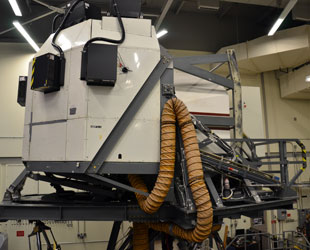
December 29, 2011
— NASA's long-running space shuttle program came to its end in 2011,
but thanks to a recently signed agreement between the space agency and a
Texas university, one of the winged spacecraft's iconic cockpits will
continue to "fly."
The Shuttle Motion Simulator (SMS), which for more than three decades exposed astronauts to the sights, sounds, and motions they'd experience when they launched and landed on the real orbiters, is being moved 100 miles from NASA's Johnson Space Center in Houston to Texas A&M University in College Station. Once there, the hydraulically maneuvered platform will resume work as a simulator.
The Shuttle Motion Simulator (SMS), which for more than three decades exposed astronauts to the sights, sounds, and motions they'd experience when they launched and landed on the real orbiters, is being moved 100 miles from NASA's Johnson Space Center in Houston to Texas A&M University in College Station. Once there, the hydraulically maneuvered platform will resume work as a simulator.
MORE: http://www.collectspace.com/news/news-122911a.html
gaw
Glenn A. Walsh, Project Director,
Friends of the Zeiss < http://friendsofthezeiss.org >
Electronic Mail - < gawalsh@planetarium.cc >
SPACE & SCIENCE NEWS, ASTRONOMICAL CALENDAR:
< http://buhlplanetarium.tripod.
Twitter: < http://twitter.com/
Facebook: < http://www.facebook.com/pages/
Blog: < http://spacewatchtower.
Author of History Web Sites on the Internet --
* Buhl Planetarium, Pittsburgh:
< http://www.planetarium.
* Adler Planetarium, Chicago:
< http://adlerplanetarium.
* Astronomer, Educator, Optician John A. Brashear:
< http://johnbrashear.tripod.com >
* Andrew Carnegie & Carnegie Libraries:
< http://www.andrewcarnegie.
* Civil War Museum of Andrew Carnegie Free Library:
< http://garespypost.tripod.com >
* Duquesne Incline cable-car railway, Pittsburgh:
< http://inclinedplane.tripod.
* Public Transit:
< http://andrewcarnegie2.tripod.
No comments:
Post a Comment